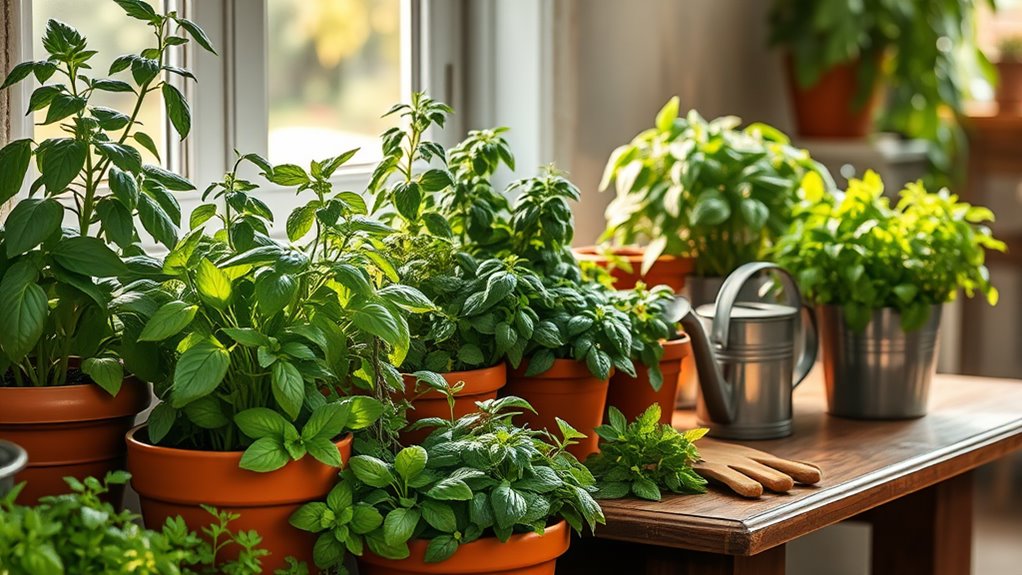How I Got Better Results Using This Kitchen Herb Garden Trick
Imagine trying to grow basil for your homemade pesto, only to find your plants struggling in a crowded pot. By selecting herbs that complement each other and your cooking habits, you can transform your kitchen garden into a thriving oasis. This simple yet effective strategy sets the stage for a bountiful harvest. Curious about how to implement this method and what herbs to choose? Let’s explore the essential steps for maximizing your kitchen herb garden’s potential.
Understanding the Basics of Kitchen Herb Gardening
Have you ever wondered how easy it’s to grow your own kitchen herbs?
Starting a kitchen herb garden requires just a few basics.
Starting your own kitchen herb garden is simple and requires just a few essential steps.
First, choose the right location; a sunny windowsill or balcony works wonders.
Next, select herbs you love—basil, parsley, and thyme are great options.
Use quality potting soil and ensure your pots have drainage holes.
Water your herbs regularly, but don’t overdo it; they thrive in moist, well-drained conditions.
Finally, harvest regularly to encourage growth and enjoy fresh flavors in your meals. Starting an indoor herb garden can be a rewarding experience that enhances your cooking.
With these simple steps, you’ll have a thriving kitchen herb garden in no time!
The Unique Trick That Changed Everything
One unique trick that can transform your kitchen herb garden is choosing the right herbs based on your cooking habits. Pairing this with optimal planting techniques, like proper spacing and soil selection, can significantly boost your plants’ growth and flavor. Additionally, understanding herb growth patterns can help you schedule planting times for maximum yield.
Choosing the Right Herbs
How do you ensure your kitchen herb garden thrives? Start by selecting the right herbs suited for your cooking style and climate. Here’s a simple guide to help you choose:
| Herb | Sunlight Needs | Culinary Uses |
|————-|—————-|———————-|
| Basil | Full sun | Pesto, salads |
| Parsley | Partial sun | Garnish, soups |
| Thyme | Full sun | Roasting, marinades |
| Cilantro | Full sun | Salsas, curries |
| Chives | Partial sun | Salads, dips |
With this selection, you’ll make your kitchen herb garden not just successful, but truly flavorful!
Optimal Planting Techniques
When it comes to planting your herbs, the technique you choose can make all the difference in their growth and flavor.
Start by using well-draining soil and adding organic compost for nutrients.
Space your herbs adequately to prevent overcrowding, which can lead to disease.
Consider companion planting; for instance, basil and tomatoes thrive together.
Water your herbs consistently but avoid overwatering, as this can cause root rot.
Finally, consider using raised beds or containers, which provide better drainage and control over soil quality.
With these optimal planting techniques, you’ll set the stage for a thriving kitchen herb garden.
Preparing Your Space for Maximum Growth
To ensure your kitchen herb garden thrives, start by selecting an ideal location that gets plenty of sunlight, ideally six to eight hours a day.
Next, focus on soil quality; use a well-draining potting mix enriched with organic matter to provide the essential nutrients your herbs need. Additionally, consider incorporating a well-draining potting mix to avoid waterlogged roots and promote healthy growth.
With the right spot and soil, you’ll set the stage for maximum growth.
Selecting Ideal Location
Selecting the ideal location for your kitchen herb garden is crucial, as it directly impacts your plants’ growth and health.
Choose a spot that receives at least 6 to 8 hours of sunlight daily.
South-facing windows or a sunny patio are excellent options.
Ensure the area has good air circulation to prevent mold and pests.
If you’re using containers, consider placing them where they can easily be moved to catch sunlight or shelter from harsh weather.
Lastly, avoid areas with heavy foot traffic, which can disturb the plants and hinder their growth.
Proper placement sets the stage for thriving herbs.
Soil Quality Matters
Soil quality is the foundation of a successful kitchen herb garden, and getting it right can significantly enhance your plants’ growth. Start by testing your soil’s pH, which should ideally be between 6.0 and 7.0. Incorporate organic matter like compost to improve drainage and nutrient levels. Here’s a quick reference table to help you choose the right soil components:
| Component | Purpose | Recommendation |
|—————-|—————————|———————|
| Compost | Adds nutrients | 30% of mix |
| Peat Moss | Improves moisture | 40% of mix |
| Perlite | Enhances drainage | 30% of mix |
Prepare your space wisely!
Essential Herbs to Start With
Starting your kitchen herb garden can be a rewarding experience, especially when you choose the right herbs to cultivate.
Begin with basil, a versatile herb that enhances many dishes. Parsley is another great option; it’s easy to grow and adds freshness to salads. Consider chives for their mild onion flavor, perfect for garnishing. Rosemary thrives in sunny spots and adds depth to roasted meats. Lastly, mint is fantastic for teas and desserts but can be invasive, so plant it in a pot. Additionally, these herbs can also thrive on a windowsill with proper care, ensuring you have fresh ingredients at your fingertips.
These herbs not only elevate your cooking but also encourage you to experiment with new flavors and recipes.
Maintenance Tips for Thriving Herbs
How can you ensure your herbs not only survive but thrive in your kitchen garden?
Start by providing adequate sunlight—most herbs need at least six hours daily.
Ensure your herbs receive at least six hours of sunlight each day for optimal growth.
Water them regularly, but avoid overwatering; ensure the soil drains well.
Prune your herbs frequently to promote bushiness and prevent flowering, which can alter flavor.
Use organic fertilizers every few weeks to boost growth, and keep an eye out for pests.
Rotate your herbs if you grow them in containers to prevent soil depletion.
Lastly, harvest regularly to encourage new growth and keep your garden vibrant and productive.
Enjoying the Fruits of Your Labor
What’s more satisfying than using your own homegrown herbs in your cooking? When you snip fresh basil for a pasta dish or sprinkle oregano on homemade pizza, you elevate flavors like never before.
To enjoy your herbs fully, harvest in the morning when oils are most potent. Rinse them gently to remove any dirt, then use them immediately or store them in a damp paper towel in the fridge.
Experiment with combinations—chop rosemary and thyme for roasted vegetables. Incorporating herbs like turmeric can further enhance your dishes, adding both flavor and health benefits.
You’ll find that your meals not only taste better but also feel more rewarding, showcasing the effort you invested in your herb garden.

